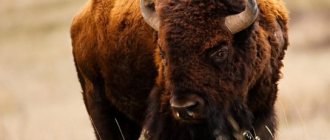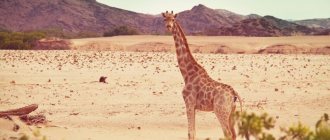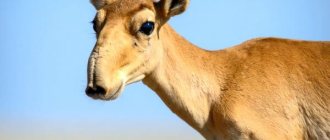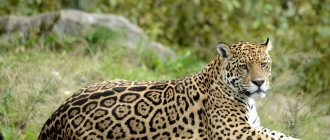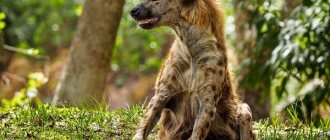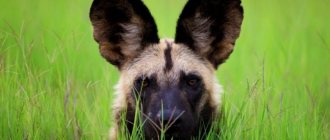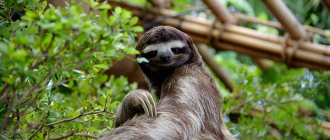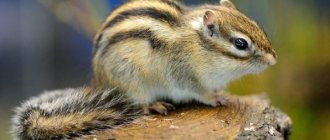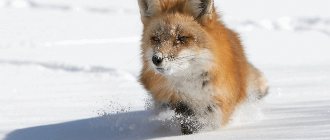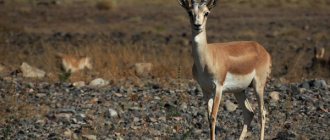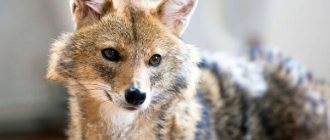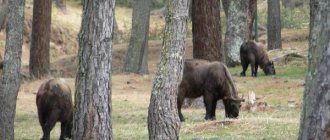- Wild animals
- >>
- Mammals
The bison is a representative of very large, powerful, and incredibly beautiful herbivores.
In appearance they are very similar to the European bison, they can easily be confused. Animals of both species often interbreed, forming offspring called bison. The greatness, fearlessness and indestructible calm of the animal inspire fear and respect. The dimensions of herbivores provide them with undisputed primacy among all existing ungulates on earth.
Origin of the species and description
Photo: Bison
Bison is a chordate mammal. They are representatives of the artiodactyl order, the bovid family, and are classified into the genus and species of bison. As a result of excavations, zoologists discovered that during the Pliocene period, that is, about 5.5-2.5 million years ago, they already existed on earth.
Scientists suggest that at that time the habitat was approximately the territory of modern southern Europe. After a certain period of time, in the Pleistocene, animals spread throughout Europe, and later even appeared in North America.
Scientists claim that the Bering Land Bridge, which existed approximately 650 thousand years ago, helped them get there. In this territory, a small subspecies of bison was formed, which settled in the southern part of Beringia. Bison of that time were almost twice the size of modern bison. They were distinguished by their rapid adaptation to living conditions, but over time and climate change, bison decreased by almost half.
Video: Bison
Approximately 100,000 years ago, the Ice Age began and the European steppe bison population spread throughout North America. In this area they inhabited the Beringian tundra and steppes. At that time, this territory had all the conditions for favorable existence and reproduction. Thanks to this, their numbers exceeded the populations of mammoths, reindeer, musk oxen, and other ungulates.
Due to changes in climatic conditions that occurred approximately 14,000 years ago, the water level in the ocean rose greatly, so the Bering land bridge was completely flooded. The ecosystem was disrupted, as a result of which the habitat of the Eurasian bison was completely destroyed.
In Europe, bison evolved from the European bison. This species has adapted to living in green deciduous forests. On the territory of the American continent, a mixture of ancient and steppe bison occurred; two varieties of bison were formed: forest and local.
At the beginning of the 16th century, the animals were common, the population was large - it numbered about 600,000 individuals. They formed huge populations and occupied an area from the Mississippi to the Rocky Mountains, occupying a range from Alaska to the northern region of Mexico.
Tourist potential
In Russia, forest bison live only in Yakutia. According to the agency's interlocutor, this could make observing artiodactyls attractive to tourists.
“The Tympynai nursery in the Mountainous region is too inaccessible for tourists. But the Ust-Buotama nursery was included in the so-called tourist route of attractions. People who go to look at the Lena Pillars (Khangalassky district of Yakutia) often stop at the nursery to see the bison, since they are in the same direction,” explained Smetanin.
The authorities of the Suntarsky district of Yakutia also see the tourism potential, who signed an agreement with the directorate of biological resources on the free transfer of two batches of 10 forest bison to the district in 2022 and 2023. In the Talygyr area of the Suntar district, an enclosure for keeping bison has already been built, food has been delivered, and conditions have been created for keeping wild animals. As reported by the district administration, construction is underway at the Suntar Forest Bison Park with an area of more than 161.1 thousand square meters. m.
“We have already transferred 10 bison to the district, and we are currently preparing documents to transfer the animals to the administration. Other areas also approached us with proposals to raise bison. But we decided to first look at the experience with the Suntar district,” said the biologist.
Appearance and features
Photo: Animal bison
The appearance of the animal is truly impressive. The height of an adult at the withers is about two meters, the length of the body is 2.7-3 meters. Body weight – 1000 – 1200 kilograms. Among these mammals, sexual dimorphism is pronounced - females are smaller and lighter than males. The weight of one adult female does not exceed seven hundred kilograms.
The bison's head is powerful, large and located on a massive, thick neck. On the head there are thick, sharp, long horns, the ends of which are curved towards the body. The animals' ears are small, rounded, hidden in the fur. Large, round, black eyes are located at a considerable distance from each other. Bison have a high, massive, pronounced forehead.
A distinctive feature is dark, elongated hair in the head, neck, chest and forelimbs. This coat makes the animal look even more menacing.
In the area where the neck meets the body, the animal has a large hump, which makes the animal’s body even more bulky and intimidating. The back part of the body is significantly smaller than the front, covered with short, thin, lighter hair.
The animals have not too long, but strong and strong limbs with well-developed muscles. Bison have a small tail, at the tip of which there is a tassel of dark wool. Herbivores have very acutely developed hearing and sense of smell.
The coat color is dark brown or dark gray; they may have a lighter shade of coat. In the area of the front part of the body, all representatives of this species have much darker fur.
Interesting fact. The animals have a mop of thick fur that looks very much like a hat.
Interesting Facts
Bison are unique creatures, one of the oldest creatures on earth. During this time, people managed to sufficiently study their habits and way of life.
But still some facts about amazing herbivores make ordinary people admire them.
Interesting Facts:
- Since ancient times, poachers have killed hundreds of bison not only for meat. The most valuable trophy is considered to be the fat that accumulates in the animal’s hump and its tongue.
- Local Indians still store bison meat for future use. They dry, cure and salt strips of meat to eat during the winter. Animal fat is also stored in special wooden boxes.
- Bison are so ancient that their bones are found alongside the remains of mammoths. Surprisingly, the first archaeological finds were discovered not in North America, but in South Asia. Scientists concluded that the animals migrated to another continent during cataclysms. After all, now bison are found only in America.
- Female and male bison become sexually mature at the same time by three or four years after birth.
- A dish made from bison meat and fat is considered a national delicacy and is called pemmican. Such rations adorned not only the tables of the aborigines, but were also used during long expeditions and travels. Properly prepared meat and fat were not afraid of cold or heat and were stored in backpack bags for several months.
- Bison are considered taciturn animals. They express most emotions with characteristic poses and movements.
- Males use the same method as bears to intimidate opponents and enemies. They lower their heads to the ground and make pendulum-like movements. If the opponent is not impressed, they begin to dig into the ground with their hooves and horns.
- Animal bones were used to make dishes, weapons and other household items. The incredibly strong bone retained its qualities for a long time. Ancient buffalo bone tools are still used by local tribes. And archaeological finds remained strong, even after lying in the ground for several centuries.
- A newborn calf is able to move within a few hours, and after a day to follow the herd.
- The sinews of the animals replaced threads for the Indians and were used to make bow strings.
- Adult animals are very peaceful and rarely start fights within the herd. The exception is the mating season, when males fight for the female.
- The front part of the bison's body is covered with long hair; the back part and tail have rather short hair.
- The ropes woven from hair and wool are so strong that they can withstand a load of several tons.
- The Indians used dry droppings as fuel for stoves.
- When boiled, local residents made glue from the hoof horn, and from the skins they made clothes, tents and other household items.
- Prehistoric ancestors were much larger than modern animals. For example, the size of the horns of an adult bison reached three meters. In modern animals, horns grow from 40 to 60 cm.
- Bison are diurnal animals, but during hot periods they prefer to go out to pasture in the morning and evening hours.
- Despite their gigantic size, bison, like all herbivores, are quite shy. They have an excellent sense of smell and hearing, but poor eyesight. Therefore, large moving objects can scare away the herd, which in panic can trample any danger.
- Bison are considered the closest relatives of bison. But scientists have proven that buffaloes also have a lot in common with shaggy giants. The structure of the forelimbs, the shape of the horns and the presence of a hump confirm the researchers' theories.
- Bison are rightfully recognized as the largest animals in North America. The weight of an adult male is from 1200 to 1500 kg, while the height at the withers can exceed the two-meter mark.
- A distinctive feature of bison is their massive hump, which makes the herbivores appear larger and bulkier.
- Bison and mestizos (buffalo + bison) are kept as livestock. They are good-natured and peaceful, and are also characterized by rapid growth and unpretentiousness.
- The speed of a bison is from 60 to 70 km/h.
- Giants are vegetarians and prefer exclusively plant foods. They can eat both fresh greens and last year’s vegetation.
- Bison are excellent swimmers and can overcome a stormy river or a deep lake.
- During the mating season, males practically do not eat, as they are busy protecting females and procreating the family. During this time, giant bulls can lose from 80 to 120 kg.
- The fur of newborn calves is bright orange and only becomes darker as they get older.
- Newborn bison do not have a characteristic hump, so in appearance they resemble ordinary domestic calves. The characteristic bulge appears at the age of one year.
- To escape from the midges, bison roll out in dust and dirt.
Where does the bison live?
Photo: American bison
The main habitat of bison is concentrated in North America. Just a few centuries ago, the bison population numbered more than 60 million individuals. Huge herds lived almost everywhere. Due to the extermination of animals, their numbers have sharply decreased, and their habitat is only two or three regions in the Missouri region.
In the distant past, animals led a nomadic lifestyle, moving to the southern regions during the cold season, and moving back with the onset of warmth. Today, such a phenomenon is impossible, since the habitat is significantly limited to farm and agricultural lands.
As regions for living, bison choose areas with rich, lush green vegetation. They feel great in endless valleys or thickets of broad-leaved trees. Bison populations are also found in open forests, valleys, and plains.
Regions where bison live in natural conditions:
- the area around Lake Athabasca;
- Slave Lake Area;
- northwest regions of Missouri;
- forest area and river basin: Buffalo, Peace, Birch.
Bison can be forest or steppe inhabitants. Species that prefer to live in valleys and open areas are concentrated south of Canada. Populations that choose forests as their region of residence are located to the north.
Interesting historical fact. The part of the continent on which New York is located is located in shallow waters, which were formed as a result of a large accumulation of bodies of bison that drowned while trying to swim across the Hudson Strait.
Habitats
Wood bison first became known in the late 19th century. Scientists believe that their ancestors were primitive bison.
Where do bison live? And where did you live? The beginning of this genus was once laid by wild bulls (genus Leptobos), which lived in the Pliocene (about 35,000 years ago) in India. Today there is a hypothesis that it was they who spread north into the wide steppes and evolved into steppe bison.
From the expanses of the Siberian bison, along the earthly passage that existed at that time, they came to North America. This version appeared in connection with the discovery of a fossil specimen of this bull in Alaska (Yukon Island) in 1979.
And where do bison live (in which country)? In addition to Canada and the United States, American wood bison are currently being reintroduced back to Alaska. The very first batch of 53 individuals was brought to these places in 2008. But despite efforts being made to preserve the population, the future of the bison remains in doubt. Dangers to their life: various diseases that massively affect cattle, and their mixing with steppe bison, which is undesirable.
What does a bison eat?
Photo: Bison Red Book
The bison is an exclusively herbivore. One adult needs to eat at least 25-30 kilograms of vegetation per day.
What is included in the animal's diet:
- Lichens;
- Moss;
- Cereals;
- Grass;
- Young shoots of bushes;
- Branches;
- Lush, green foliage.
With the onset of cold weather, they begin to feed on plant debris. Animals are perfectly adapted to survive even in persistent frosts down to -25 and below. Powerful limbs make it possible to dig out plants even under deep snow debris one or more meters thick. They rake them with their hooves and dig holes with their foreheads. It is for this reason that many individuals have bald spots on the frontal part of the head.
Every day animals come to the pond without fail to quench their thirst. It is not possible to get enough to drink only during periods of frost and freezing of water bodies. Animal grazing occurs mainly at dusk or early in the morning. This way, the risk of becoming a victim of a predator is reduced; moreover, during the day, during periods of strong sunshine, they take refuge in the shade of vegetation, or in a forest.
Depending on the abundance and quantity of food, herds of bison wander from place to place. When choosing a route, animals stick to bodies of water. Capable of covering long distances. Subsequently, with warming, they can return to their previous habitat. Lack of food, especially in the cold season, affects the quality of wool. Therefore, during severe frosts, animals that lack plant food may suffer from the cold.
Features of character and lifestyle
Photo: Bison
Bison are herd ungulate animals. They form large herds, which in former times reached 17,000 - 20,000 individuals. The head of such a huge herd is always the wisest and oldest, but strong male. In such large herds, dominance can be shared by several males at once.
Males, together with females and born offspring, form a separate, small herd. The task of the main males is to protect the herd from strangers and enemies. Thanks to their superbly developed hearing and sense of smell, they are able to sense and detect danger long before it approaches.
Interesting fact. Bison are able to detect a stranger by smell at a distance of more than 3000 meters.
Despite their enormous body size, bulk and power, animals can be very fast and dexterous. They are able to overcome obstacles up to two meters high, gallop and reach speeds of up to 50 km/h. It is for these reasons that the inhabitants of America abandoned attempts to domesticate this giant.
In addition to agility and dexterity on land, they are excellent swimmers and are able to overcome significant distances by swimming.
Outwardly, the bison seems clumsy, very reserved and serene. If there are no irritating factors, the animal seems absolutely calm. If a bison gets angry, it turns into a real death machine. When angry, he becomes very furious, ruthless and very cruel.
There have been cases when bison, when pursued by predators, knocked down weaker and sicker individuals. In this way they dumped unnecessary ballast. This representative of herbivores is very smart and is able to objectively assess the situation. During a fight, if the enemy has an advantage, he retreats without exposing himself to mortal danger.
Animals tend to communicate with each other through the production of certain sounds - dull, menacing and low growls.
Social structure and reproduction
Photo: Baby Bison
It is unusual for bison to create strong, long-lasting pairs. During the mating period, one male can have a whole harem, consisting of three to five or more females. The mating season is quite long - lasts from May to mid-autumn. During a given period of time, single males, or herds, connect with populations of female individuals.
A large herd is formed, in which serious competition begins between the males and the struggle for the right to enter into a relationship with the female. Battles between males manifest themselves in the form of butting heads and confronting each other. Often such clashes end in the death of the weaker enemy. The winner is rewarded with the attention of the female. During the rutting period, males emit a powerful, strong, and very dull roar, reminiscent of the approach of a thunderstorm. They can be heard at a distance of 5-7 kilometers.
After mating, a pregnancy period begins, which lasts for 9-9.5 months. Most often, the female looks for a secluded, remote place for childbirth and leaves at the moment of its occurrence. If she does not have time to find one, the calf is born right in the herd. One female can give birth to only one calf; the birth of two babies is extremely rare. Other members of the herd show tenderness and care for the baby - they lick, protect, and take care of it.
1.5-2 hours after birth, the baby can already stand on his feet and move after his mother.
Calves feed on fatty, high-calorie mother's milk until they are one year old. They very quickly gain body weight, grow stronger and mature. Calves are very nimble, playful, and restless, they love to jump and run. However, during this period they are defenseless and are easy prey for predators, so they are constantly in the field of view of adults. Bison reach sexual maturity at the age of 3-5 years. The average life expectancy in natural conditions is 23-26 years.
Natural enemies of bison
Photo: Bison animal
Due to their power, strength and enormous size, bison have virtually no enemies among representatives of the animal world in natural conditions. The exception is wolves, which hunt young calves, as well as old and sick individuals. Predators are unable to defeat young and strong bison; even spruce trees will attack them in a whole flock. Bison populations have declined significantly in recent centuries due to extensive human intervention. They were actively hunted by the Indians, whose way of life largely depended on these powerful herbivorous mammals.
Of particular value were the tongue and the hump, which was a storehouse of fat from which provisions were made for the winter period. Animal skins served as a source of raw materials for making clothing, and particularly thick and dense sections were used to make shoes and shoe soles. The Indians used every part of the animal's body without exception.
In addition to clothing, tents, riding gear, cart reins, belts, etc. were made from leather and skins. Bison hair was a source for weaving strong ropes. Bones were used to make sharp cutting objects, kitchen utensils, fuel was made from droppings, and an adhesive was made from hooves.
However, scientists have found that until 1840, human activity did not play a decisive role in the extermination of the species and the reduction in its numbers.
Population and species status
Photo: Bison from America
Over the past few centuries, bison numbers have declined to catastrophic levels. In natural conditions there are no more than 35,000 animals. The bulk of the population consists of steppe bison. It is also worth noting that animals are quite successfully bred on private farms. According to zoologists, the number of ungulates kept in captivity reaches 5,000 individuals.
This type of herbivore is listed in the Red Book. It has been given the status of a species on the verge of complete extinction. Bison are bred en masse for industrial purposes on special farms. According to zoologists, there are about half a million animals on the territory of such farms.
At the beginning of the 18th century, there were about 60 million animals in natural conditions. After 1840, active hunting for herbivores began. It acquired incredible proportions just 25 years later. At that time, the construction of a transcontinental railway line began, and in order to attract passengers, and, consequently, income, passengers were invited to become participants in an exciting journey.
Passengers on a moving train could open fire on peacefully grazing animals, leaving behind dozens of dying animals. They were also killed to obtain meat to feed the workers who worked on the construction of the railway. There were such a huge number of bison that often their carcasses were not even butchered, only the tongue was cut out.
Interesting historical fact. The number of buffalo hunters grew steadily. By 1965 there were more than two million. The most ardent - Buffalo Bill - destroyed 4280 individuals.
Good-natured but wild
Semyon Semenovich - jokes based on “The Diamond Arm” are perceived by Egorov with weary favor - turned 55 in January. A great veterinarian, local, specialist in large horned animals, doesn’t drink at all... In short, you couldn’t find a better candidate - when in 2006 the first ones were brought from a Canadian nature reserve 15 pairs, was assigned to the bisonarium. Before that, Egorov had only heard about bison from Westerns and had no idea about their size. “They are good, giants. And I’m already used to them,” says Egorov.
All Yakut bison are now 175
Photo: Yuri Vasiliev / Lenta.ru
The infrastructure in the bisonarium is modest: several one-story wooden houses, one of them contains Yegorov’s central office. It has an iron stove, which means it’s warm, and that’s the main thing. “Many guests of the reserve are very impressed by this,” Andrei Popov points to the rows of well-built fortified trailers near the fence. The Canadians brought bison to them - the same way: along the ice of the Lena, along the ice of Kirim, further to the right and into the forest to Ust-Buotama. They also transport the young animals to the Sinskaya Pillars - almost five hundred kilometers from here, on the Sinaya River.
“The nursery is called Tympynai,” explains Egorov. - A hundred kilometers around in any direction - no one at all. Not like here.” Not far from Ust-Buotama - about eighty kilometers - are the famous Lena Pillars; tourists sometimes come here too. They are welcome, of course. “We’re just always worried about giants and cows,” says Semyon Semenovich.
“They are very good-natured by nature, but wild,” Semyon Egorov describes his charges. - If you don’t touch it, it won’t be touched. If you drive into a cramped space, into the same corral - everyone, beware, they will demolish you. The bison is a Russian animal.”
The “Canadians” began giving birth in Yakutia within two years, which surprised the donors: usually, when placed in new places, it takes three or even four years for offspring to be born. The dilemma of the cat Matroskin does not face the Yakut bison: 90 bison from Canada are theirs, and the calves are also Russian. Unless donated ones cannot be moved from Ust-Buotama, according to the agreement. And the offspring - please.
One pair of young bison was transported to Mirny, to diamond miners - Alrosa once helped with transportation from Canada. The second one was last year - to the Orto Doidu Zoo near Yakutsk. “They thought they would break the fence,” recalls Andrei Popov. “It turned out that they just needed to be kept in silence for a week or two, that’s all.” They live there great, they’re used to it.”
“Their names are Ilyusha and Sargulya, they eat from the hand,” confirms Semyon Egorov. “The enclosure is big there, it’s good, but it’s not like the open spaces here.”
